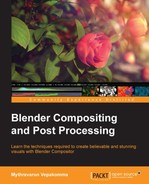Book Description
From basic grading techniques through to advanced lighting and camera effects, this guide to compositing with Blender teaches digital CG artists the way to bring a new level of dynamism and realism to their footage.
What You Will LearnIn Detail
Blender Compositing allows you to assemble and enhance an image (or movie). Using Composition nodes, you can glue two pieces of footage together and colorize the whole sequence all at once. You can enhance the colors of a single image or an entire movie clip in a static manner or in a dynamic way that changes over time (as the clip progresses).
Blender Compositing and Post Processing enables you to attain a firm grounding in order to arrive at a desired look of the film, with more ease and efficiency. You will also learn how to create and manage compositing flows that are effective and productive in meeting project deadlines.
Blender Compositing and Post Processing will take you through different compositing terminologies, concepts, and their implementations in Blender Compositions. You will indulge in procedural and practical illustrations on color space, image grading, relighting, and focusing.
This book is a one stop solution for you to attain state of the art compositing skills for creating mind blowing visuals and productive composites, using Blender compositor. By the end of the book you should have the confidence to tackle a complex shot from planning to polish.
What You Will Learn
- Explore color spaces and grading techniques
- Discover what goes in and out of Blender compositor
- Understand generic render passes and layers
- Work on advanced compositing techniques like relighting, texture mapping, and focusing
- Get to grips with keying, masking, and filtering techniques
- Grade using the Bezier curve
- Make the image more realistic using camera effects
- Import footage into the node editor
Downloading the example code for this book. You can download the example code files for all Packt books you have purchased from your account at http://www.PacktPub.com. If you purchased this book elsewhere, you can visit http://www.PacktPub.com/support and register to have the files e-mailed directly to you.
Table of Contents
- Blender Compositing and Post Processing
- Table of Contents
- Blender Compositing and Post Processing
- Credits
- About the Author
- Acknowledgments
- About the Reviewers
- www.PacktPub.com
- Preface
- 1. Blender Compositing – Overview
- 2. Working with Blender Compositor
- 3. Working with Input and Output Nodes
- 4. Image Manipulation Techniques
- 5. Beyond Grading
- 6. Alpha Sports
- Index
